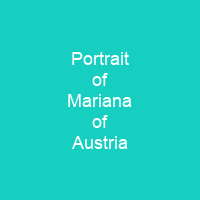Portrait of Mariana of Austria is a 1652–1653 oil-on-canvas painting by Diego Velázquez. Its subject, Doña Mariana, was the daughter of Emperor Ferdinand III and Maria Anna of Spain. Mariana had been betrothed to her first cousin, Prince Baltasar Carlos. She became queen consort on their marriage, and after her husband’s death in September 1665, regent during the minority of her son, Charles II.
About Portrait of Mariana of Austria in brief

The portrait is painted in shades of black and red, and her face is heavily made up. Her right hand rests on the back of a chair, and she holds a lace handkerchief in her left hand. Her bodice is decorated with jewellery, including a gold necklace, bracelets and a large gold brooch. A clock rests on scarlet drapery behind her, signifying her status and discernment. As an official court portrait, the painting adheres to every official court convention, with every attempt to convey a sense of majesty in Mariana’s extravagant taste. The paintings are marked by an emphasis on bright hues against dark backgrounds, extravagant head-dress, and fashionably wide dresses. The series culminates with the 1656 Las Meninas, which includes Mariana and, at center-stage, her daughter the Infanta Margarita Teresa. Miana had a difficult life. She was described as a \”ruddy-cheeked, naive girl who loved a good laugh\”, and her day-to-day courtly duties came to weigh heavily on her.
You want to know more about Portrait of Mariana of Austria?
This page is based on the article Portrait of Mariana of Austria published in Wikipedia (as of Nov. 07, 2020) and was automatically summarized using artificial intelligence.







